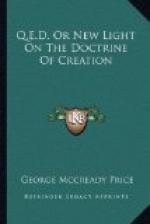Of the three general postulates or a priori assumptions of this curiously out-of-date mediaeval science, namely, (1) Uniformity, (2) the Cooling globe theory, and (3) the theory of the Successive Ages, the first two have already been examined and found wanting by other investigators, and have been allowed to lapse into a sort of honored disuse, though their memory is still reverently cherished in all the text-books of the science. The “Challenger” Expedition dissipated most of the myths that had long been taught regarding the deep waters of the ocean; and Professor Suess has disposed of the closely related myth about the coasts of the continents being constantly on the seesaw up and down. These two discoveries, with others that might be mentioned, dispose of Lyell’s theory of uniformity. Lord Kelvin and the other physicists dissipated the idea of a molten interior of the earth. Hence, because these other false hypotheses have already in a measure been disposed of, as well as for the sake of brevity, I shall here discuss only the third of the prime postulates of the current system of geology, namely the theory of Successive Ages. And when we have adjusted this aspect of the science of geology to the facts of the rocks as made known to us by modern discoveries, we shall find little in this science out of harmony with the older view of a literal Creation as taught in the Bible and as already confirmed by the other branches of science which we have been examining.
There are five leading arguments against the reality of these successive ages. Four of them must be dismissed here by a brief summary of the facts as we know them to-day, referring the reader to the author’s larger work, where detailed evidence is given for each. The fifth series of facts I shall give here in more detail, though of course even this must be but an outline of what is given elsewhere.
1. In the earlier days of the theory of successive ages it was taught that only certain kinds of fossils were to be found at the bottom of the series, or next to the Primitive or Archaean. This feature of the theory was demanded by the supposed universal spread of one type of life all around the globe in the earliest age. But it is now known that the so-called “oldest” fossiliferous rocks occur only in detached patches over the globe, while other or “younger” kinds are just as likely to be found on the Primitive or next to the Archaean. Not only may any kind of fossiliferous rocks occur next to the Archaean, but even the “youngest” may be so metamorphosed and crystalline as to resemble exactly in this respect the so-called “oldest” rocks. On the other hand some of the very “oldest” rocks may, like the Cambrian strata around the Baltic and in some parts of the United States, consist of “muds scarcely indurated and sands still incoherent."[40]
[Footnote 40: J.A. Howe; Encyclopaedia Britannica, Vol. II, p. 86. Cambridge Edition.]




